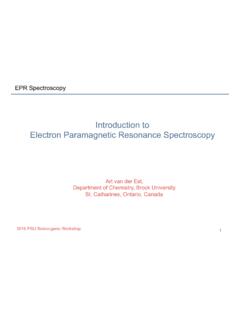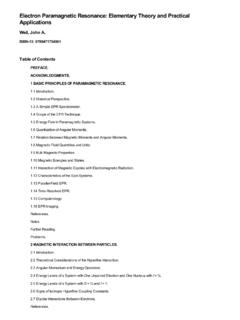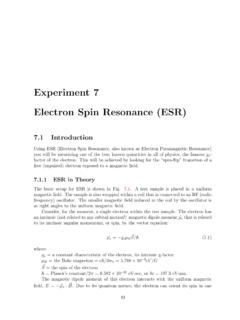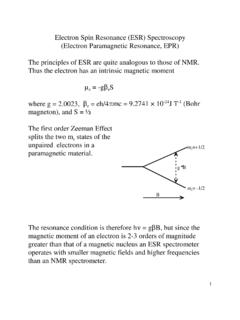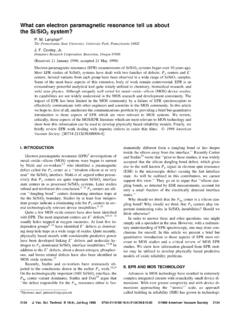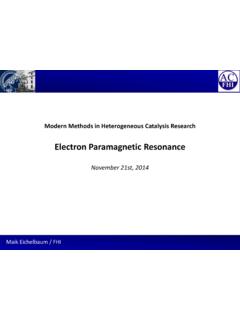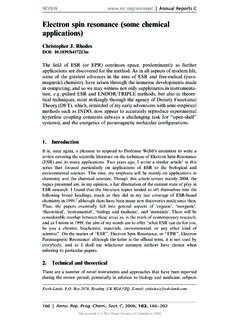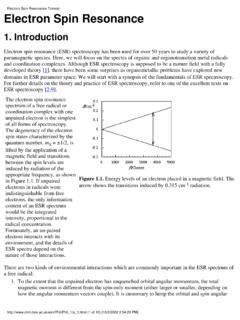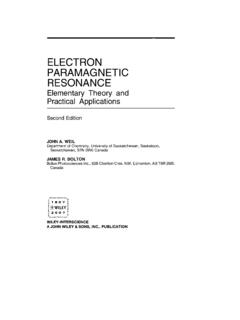Transcription of 5 Paramagnetic Electron Resonance - home.uni-leipzig.de
1 Chapter 5, page 1 5 Paramagnetic Electron Resonance By splitting the Electron ground state in a strong external magnetic field, we get Zeeman resonances in the gigahertz range of the electromagnetic spectrum. The observation of these spectra is the basis of Electron Paramagnetic Resonance (EPR) spectroscopy, which is also known as Electron spin Resonance (ESR). When Jewgeni Sawoiski first observed in 1944 Electron spin Resonance absorption in a copper(II) chloride dihydrate sample submerged in a mT field at 133 MHz, Electron paramagnetism had already been known for a long time. Otto Stern and Werner Gerlach had already demonstrated it in their famous experiment of 1921: a collimated beam of silver atoms, which are in the ground state 2S at room temperature (one 5s Electron , the other shells are full or empty), passes parallel to the edge of the wedge-shaped pole shoe of an electromagnet, so that the magnetic field and its gradient are aligned parallel (z-axis).
2 The atomic beam travels perpendicular to this direction. A homogenous magnetic field only affects the orientation of microscopic magnetic moments , see chapter The inhomogeneous magnetic field, however, applies a force in the z direction BzzzBBF == wheredd ( ) which diverts the atomic beam in this direction. From equ.( ), we get maximal deflection with opposite sign for microscopic magnetic moments in the z and z-directions. z x y zAg Source Fig. Stern-Gerlach Experiment. The cross section of the magnet, and the beam of silver atoms coming from the gas reservoir. The beam is collimated by masks and split in the inhomogeneous magnetic field. The detector was a cooled glass plate to which the silver atoms stuck. The spots were seen after chemical development. According to classical laws, we should observe deflection in the direction of the gradient of the magnetic field for random orientations of (except for perpendicular orientation of the dipole to the external field).
3 In applying the inhomogeneous magnetic field, the cross section of the atomic beam was not even approximately continuous. Two spots instead of one were seen along the z axis. Two conclusions could be drawn from the experiment: 1) the existence of the magnetic moment of the electrons (whose connection to the spin of the electrons was first made in 1925 by Samuel Abraham Goudsmit and George Eugene Uhlenbeck), and 2) the proof of two preferred directions of the magnetic moment, which were later shown in quantum mechanics to be the magnetic quantization of the Electron spins in an external field. The Stern-Gerlach experiment was a major influence in the development of modern physics. It created a basis for the high frequency spectroscopic procedure used in the study of Paramagnetic substances. In 1938, Isodor Isaak Rabi developed molecular beam Resonance . EPR and NMR followed. NMR, treated in the previous chapter, is based on nuclear paramagnetism, and EPR is based on Electron paramagnetism.
4 Spectroscopy D. Freude Chapter "EPR", version June 2006 Chapter 5, page 2 Electron Paramagnetism A material is called Paramagnetic , if it has no macroscopic magnetic moment in the absence of an external magnetic field, but in a magnetic field has one which points in the direction of the field. This can be understood by imagining that the stochastically oriented microscopic magnetic dipole moments are aligned by the external field. Thus, for the occurence of Electron paramagnetism, an atomic, ionic, or molecular magnetic moment is necessary. The existence of such a magnetic moment is the same as the existence of non-filled Electron shells or the existence of unpaired electrons. Paired electrons have the same quantum numbers n, l, m, but opposite spin quantum numbers s = + and s = . In atoms or molecules with only saturated Electron shells, all electrons are paired, the resulting orbit and spin moments are zero. Nevertheless, such particles can often be examined with EPR if they are put in a Paramagnetic ground state ( creation of free radicals or triplet states) by, for example, irradiation.
5 EPR experiments concentrate on the following substances: a) Free radicals in solid bodies, liquids, or gases, which, according to definition, are an atom, molecule, or ion with an unpaired Electron , CH3. (The types mentioned later are excluded from the definition of a free radical.) b) The ions of the transition metals, belonging to the groups 3d, 4d, 5d, 4f and 5f of the periodic table. These include more than half of the elements of the known periodic table. The palette of various positive and negative ions contains up to 7 unpaired electrons. In comparatively few experiments, EPR is also used to study the following substances: c) Solid bodies with defects. The most popular local point imperfection is the F-center which causes color effects. It is caused by an Electron in an anion defect. d) Ions with a non bonding s Electron (localized 2S state), Ga2+. e) Systems with more than one unpaired Electron except for those of point b). These include on the one hand systems in the triplet state, in which a strong interaction between the two unpaired electrons usually appears in an excited state, irradiated naphtaline.
6 Bi-radicals, which show a weak interaction between the unpaired electrons and are therefore acting like two weakly interacting free radicals. f) Atom with non-filled Electron shells, atomic hydrogen or atomic nitrogen and molecules with unpaired electrons, NO. g) Metals and semiconductors, which have unpaired electrons in their conduction bands. It cannot, however, be expected that EPR experiments can be conducted on all the above substances in every case. A significant difference between NMR and EPR is just that: a strong influence of the surroundings on the orbital motion and through L-S-coupling on the Electron spins occurs in condensed material as a result of the strong coupling of the orbital magnetism to the surroundings. Thus the gyromagnetic ratio strongly depends on the environment of the Paramagnetic ion. This is not true in NMR, where the Resonance position only has a relatively weak dependency on interactions. Spectroscopy D. Freude Chapter "EPR", version June 2006 Chapter 5, page 3 The g-Factor and the Zeeman Splitting of Optical Spectra In EPR, the most important parameter for the description of the spin system is the g factor.
7 Before we define it, we will first briefly turn to orbital and spin magnetism, in which we will go from a classical to a quantum mechanical description. An Electron orbiting at radius r with the angular frequency creates a current I = e /2 where the magnitude of the elementary charge e = 1,602 10 19 C. In general, the magnetic moment of a current I, which encloses the surface A, is = IA. With A = r2 , = e r2. With the angular momentum L = me r2 ( Electron mass me = 9,109 10 31 kg), we get an orbital magnetism which depends on the angular momentum L: L = em2eL. ( ) For spin magnetism, we assume a rotating sphere of mass me and charge e (the axis of rotation goes through the center of mass). We divide this sphere into infinitesimal volume elements, in which the ratio of segment charge through segment mass is independent of segment size.
8 We then perform for each segment the same procedure that we used for an Electron in a circular orbit and add all their contributions to the dipole moment. We get a magnetic moment dependent on the Electron spin S, analogous to equ.( ): S = em2eS, ( ) in which S is the spin of the Electron . In analogy to NMR, see equations ( ) to ( ), because of the quantization of the angular momentum, we need the orbital angular momentum quantum number l and the spin quantum number s for the magnitude. L=+hll(1) and ()S=+hss1. ( ) The components in the direction of the external magnetic field in the z-direction are Lz = lz h ml h m h and Sz = msh s h.
9 ( ) There are 2l+1 magnetic quantum numbers for the orbital magnetism ml m = l, l +1, .., l 1, l ( ) and only two magnetic quantum numbers for Electron spin magnetism ms s = , + , ( ) in which the use of s in both the Electron spin quantum + and its magnetic quantum numbers could lead to confusion. Spectroscopy D. Freude Chapter "EPR", version June 2006 Chapter 5, page 4 If we consider the z-component of the magnetic moment in equ.( ) and use h, which is the smallest non-zero value of the angular momentum Lz from equ.( ), we get the Bohr magneton as the elementary unit of magnetic orbital momentum in an external magnetic field. B = em29 274 1024e2 JmVsh= ,. ( ) Based on the Bohr magneton, we will now introduce the g factor for an arbitrary magnetic quantum number m as: () =gmm B1+.
10 ( ) In the following, we will use small letters for individual electrons and capital letters for multiple electrons. It follows directly from the comparison of equ.( ) with equ.( ) and equ.( ) that gL = 1 for orbital magnetism. This has been experimentally demonstrated with an accuracy of 10 4. Equations ( ), ( ) and ( ) give us a g-factor that does not coincide with the experimental results for a free Electron . If we use h for the Electron spin S in equ.( ) and ( ), we already have a discrepancy with the experimental fact that the intrinsic magnetic moment of the Electron is a whole Bohr magneton, thus approximately the same as the one belonging to the orbital angular momentum quantum number l = 1. Apparently the classical calculation, so successful in the case of orbital magnetism, fails to yield the correct results when applied to spin magnetism.



